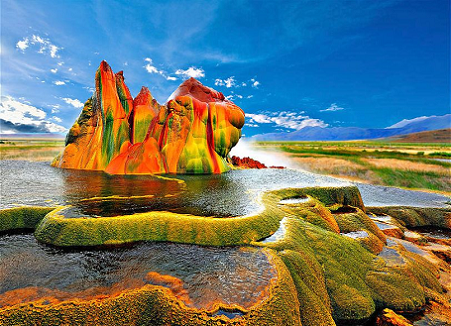Settled on a fix of private land in Nevada's Black Rock Desert, the Fly Ranch Geyser (referred to normally as the Fly Geyser) is one of the state's coolest attractions, however numerous occupants still don't have any acquaintance with it exists. Fly Geyser, which retches waters around five feet high, lies about 33% of a mile from State Route 34, a street which works as the main perspective since the fountain is not open to people in general. This outsider looking spring on the edge of Black Rock Desert is really man made. Man made unintentionally, that is. There are really two fountains on the property. The first was made about 100 years back as a feature of a push to make a part of the leave usable for cultivating. A well was penetrated and geothermal bubbling water (200 degrees) was hit. Clearly not reasonable for water system water, this fountain was allowed to sit unbothered and a 10 to 12 foot calcium carbonate cone framed. In 1964 a geothermic vitality organization penetrated a test well at a similar site. The water they struck was that same 200 degrees. Hot, yet not sufficiently hot for their motivations. The well was as far as anyone knows re-fixed, however clearly it didn't hold. The new fountain, a couple of hundred feet north of the first, burglarized the first of its water weight and the cone now lays dry. This second spring, known as Fly Geyser, has become generously in the most recent 40 years as minerals from the geothermal water take store on the abandon surface. Since there are different fountain gushes, this spring has not made a cone as substantial as the initially, yet a constantly developing outsider looking hill. The spring is secured with thermophilic green growth, which thrives in soggy, hot situations, bringing about the different shades of green and red that add to its crazy appearance. Purchasing the property is the initial step on a long voyage. As stewards of this interesting land parcel, our premier obligation is to guarantee it will be kept up for eras to come. This will require arranging and arrangement. At that point, we'll put in the following couple of years investigating the conceivable outcomes for Fly Ranch. You might ask yourself, "What does this mean for us? What would we be able to do with this? In what capacity will this profit the group?" The answers will unfurl gradually. We're far from characterizing precisely what will happen at Fly Ranch, however it's not very right on time to start longing for the potential. We're motivated by this turning point and trust you are as well.
The Coachella Valley Music and Art Festival (commonly referred to as Coachella or Coachella Festival) is an annual music and arts festival held at the Empire Polo Club in Indio, California, located in the Coachella Valley of the Royal Empire in the Desert of Colorado. It was founded by Paul Tollett and Rick Van Santen in 1999, and is organized by Goldenvoice, a subsidiary of AEG Live. The event features musicians from many genres of music, including rock, pop, indie, hip hop and electronic dance music, as well as art and sculpture installations. Through the reasons, several stages consistently hold live music. The main stages are: Coachella Stage, Outdoor Theater, Gob Tent, Mojave Tent and Sahara Tent; a smaller Oasis Dome was used in 2006 and 2011, while a new Yuma stage was introduced in 2013 and a Sonora stage in 2017. The festival's origins relate to a 1993 concert by Pearl Jam at Empire Polo, while boycotting Ticketmaster controlled sites. The show confirmed the s...





